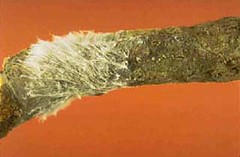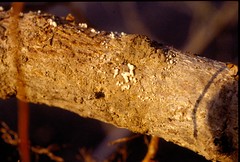Southern blight is a fungus disease caused by Sclerotium rolfsii. The disease is a problem primarily in the Piedmont apple growing region in the southeastern United States. S. rolfsii is a widespread pathogen that affects several hundred plant species. The fungus affects the lower stems and roots of apple trees, killing the bark and girdling the trees. The disease is characterized by the presence of a white, weblike mycelium, which often forms at the bases and on the lower stems of affected trees (fig. 1). Tree death usually occurs rapidly. Light brown to pink or yellow, round sclerotia, 1/16 inch to 1/8 inch in diameter, form in the mycelial mat (fig. 2). The sclerotia serve to spread the fungus and serve as overwintering structures. The disease is most severe on 1- to 3-year-old trees. Root, crown, and collar tissues become resistant to infection as the bark thickens with age.
|
Figure 1. White, weblike mycelium of the southern blight fungus. Photo: Turner B. Sutton, North Carolina State University.
|
Figure 2. Light brown to pink or yellow sclerotia of the southern blight fungus. Photo: Alan R. Biggs, West Virginia University.
|
|---|---|
To manage the disease, avoid planting apple trees on sites where the disease has been severe on previous crops such as peanuts, clover, tomatoes, and soybeans. Keep the soil around the bases of trees free of dead organic matter that serves as a food base for S. rolfsii. Some differences exist in rootstock susceptibility. The most resistant rootstock currently used is M.9. There are no chemicals registered for control of southern blight on apple trees.
Alan R. Biggs, West Virginia University


